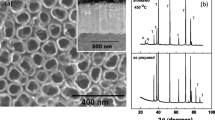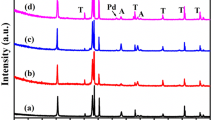Abstract
One-dimensional nanostructures grown on substrates are favored for photocatalytic reactions because of their large specific surface areas and well-defined transport paths for charge carriers. In the present paper, zinc ferrite nanotube arrays are synthesized on indium-tin-oxide–glass substrates, and their photocatalytic capabilities are evaluated by degrading an aqueous solution of rhodamine B (RhB) under visible light irradiation. The photocatalytic performance of pure zinc ferrite nanotube arrays is unsatisfactory. To improve their photocatalytic abilities, the surfaces of zinc ferrite nanotube arrays are decorated with Au nanoparticles, significantly enhancing their photocatalytic capabilities for RhB degradation. The drastic improvement in the photocatalytic degradation ability is attributed to the effective separation of photogenerated electron–hole pairs in the Au-decorated zinc ferrite hybrid nanostructure, which facilitates the generation of oxidizing free radicals (i.e., O •2 − and OH·) for RhB degradation.






Similar content being viewed by others
References
Zhang Q, Lee I, Joo JB, Zaera F, Yin Y (2013) Core–shell nanostructured catalysts. Acc Chem Res 46(8):1816–1824
Zhao J, Holmes MA, Osterloh FE (2013) Quantum confinement controls photocatalysis: a free energy analysis for photocatalytic proton reduction at CdSe nanocrystals. ACS Nano 7(5):4316–4325
Shen S, Mao Samuel S (2012) Nanostructure designs for effective solar-to-hydrogen conversion. Nanophotonics 1(1):31–50
Song H, Zhu L, Li Y, Lou Z, Xiao M, Ye Z (2015) Preparation of ZnFe2O4 nanostructures and highly efficient visible-light-driven hydrogen generation with the assistance of nanoheterostructures. J Mater Chem A 3(16):8353–8360
Zhang N, Liu S, Xu Y-J (2012) Recent progress on metal core@semiconductor shell nanocomposites as a promising type of photocatalyst. Nanoscale 4(7):2227–2238
Subramanian V, Wolf EE, Kamat PV (2004) Catalysis with TiO2/gold nanocomposites. Effect of metal particle size on the Fermi level equilibration. J Am Chem Soc 126(15):4943–4950
Jiang R, Li B, Fang C, Wang J (2014) Metal/semiconductor hybrid nanostructures for plasmon-enhanced applications. Adv Mater 26(31):5274–5309
Yao Y, Qin J, Chen H, Wei F, Liu X, Wang J, Wang S (2015) One-pot approach for synthesis of n-doped TiO2/ZnFe2O4 hybrid as an efficient photocatalyst for degradation of aqueous organic pollutants. J Hazard Mater 291:28–37
Malkhasian AYS (2015) Synthesis and characterization of Pt/AgVO3 nanowires for degradation of atrazine using visible light irradiation. J Alloys Compd 649:394–399
Wang M, Ioccozia J, Sun L, Lin C, Lin Z (2014) Inorganic-modified semiconductor TiO2 nanotube arrays for photocatalysis. Energy Environ Sci 7(7):2182–2202
Schneider J, Matsuoka M, Takeuchi M, Zhang J, Horiuchi Y, Anpo M, Bahnemann DW (2014) Understanding TiO2 photocatalysis: mechanisms and materials. Chem Rev 114(19):9919–9986
Kishimoto F, Imai T, Fujii S, Mochizuki D, Maitani MM, Suzuki E, Wada Y (2015) Microwave-enhanced photocatalysis on CdS quantum dots-evidence of acceleration of photoinduced electron transfer. Scientific Reports 5:11308
Hou Y-F, Liu S-J, Zhang J-h, Cheng X, Wang Y (2014) Facile hydrothermal synthesis of TiO2-Bi2WO6 hollow superstructures with excellent photocatalysis and recycle properties. Dalton Trans 43(3):1025–1031
Dhal JP, Mishra BG, Hota G (2015) Hydrothermal synthesis and enhanced photocatalytic activity of ternary Fe2O3/ZnFe2O4/ZnO nanocomposite through cascade electron transfer. RSC Advances 5(71):58072–58083
Lee K-T, Chuah X-F, Cheng Y-C, Lu S-Y (2015) Pt coupled ZnFe2O4 nanocrystals as a breakthrough photocatalyst for fenton-like processes-photodegradation treatments from hours to seconds. J Mater Chem A 3(36):18578–18585
Spasiano D, Marotta R, Malato S, Fernandez-Ibañez P, Di Somma I (2015) Solar photocatalysis: materials, reactors, some commercial, and pre-industrialized applications. A comprehensive approach. Appl Catal B 170–171:90–123
Boumaza S, Boudjemaa A, Bouguelia A, Bouarab R, Trari M (2010) Visible light induced hydrogen evolution on new hetero-system ZnFe2O4/SrTiO3. Appl Energy 87(7):2230–2236
Li X, Hou Y, Zhao Q, Teng W, Hu X, Chen G (2011) Capability of novel ZnFe2O4 nanotube arrays for visible-light induced degradation of 4-chlorophenol. Chemosphere 82(4):581–586
Zhou M, Zhu H, Jiao Y, Rao Y, Hark S, Liu Y, Peng L, Li Q (2009) Optical and electrical properties of Ga-doped ZnO nanowire arrays on conducting substrates. J Phys Chem C 113(20):8945–8947
Guo X, Zhu H, Li Q (2014) Visible-light-driven photocatalytic properties of ZnO/ZnFe2O4 core/shell nanocable arrays. Appl Catal B 160–161(1):408–414
Watanabe T, Takizawa T, Honda K (1977) Photocatalysis through excitation of adsorbates. 1. Highly efficient N-deethylation of rhodamine B adsorbed to cadmium sulfide. J Phys Chem 81(19):1845–1851
Takizawa T, Watanabe T, Honda K (1978) Photocatalysis through excitation of adsorbates. 2. A comparative study of rhodamine B and methylene blue on cadmium sulfide. J Phys Chem 82(12):1391–1396
Acknowledgements
This work is supported by the National Natural Science Foundation of China (No. 51502271, 11574401), the Fundamental Research Funds for the Central Universities (No. 2652015186), the National Key Basic Research Program of China (No. 2014CB744302), and the Specially Funded Program on National Key Scientific Instruments and Equipment Development (No. 2012YQ140005).
Author information
Authors and Affiliations
Corresponding authors
Electronic supplementary material
Below is the link to the electronic supplementary material.
Rights and permissions
About this article
Cite this article
Liu, H., Hao, H., Xing, J. et al. Enhanced photocatalytic capability of zinc ferrite nanotube arrays decorated with gold nanoparticles for visible light-driven photodegradation of rhodamine B. J Mater Sci 51, 5872–5879 (2016). https://doi.org/10.1007/s10853-016-9888-5
Received:
Accepted:
Published:
Issue Date:
DOI: https://doi.org/10.1007/s10853-016-9888-5




